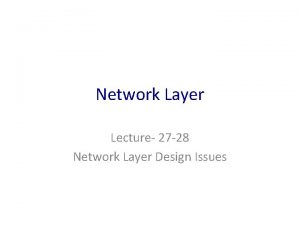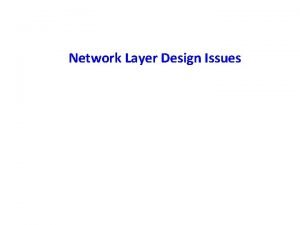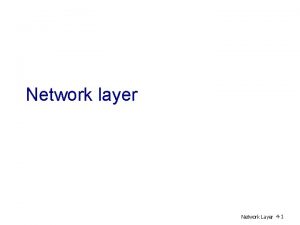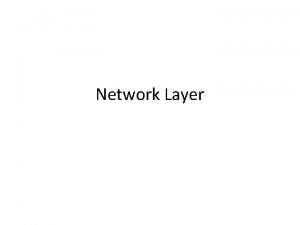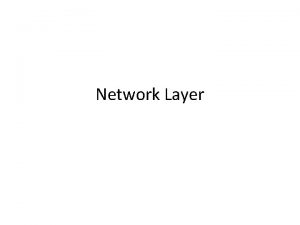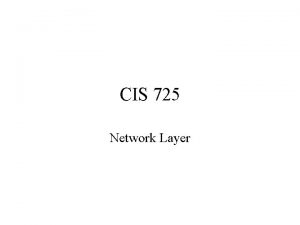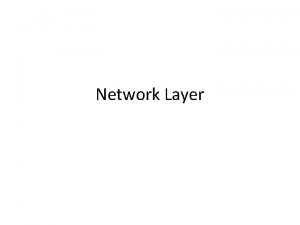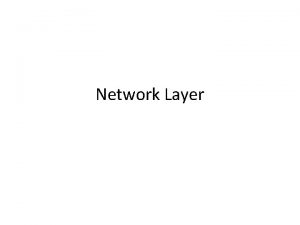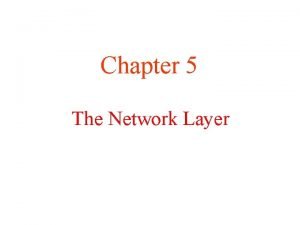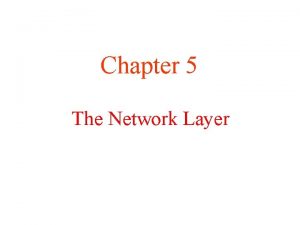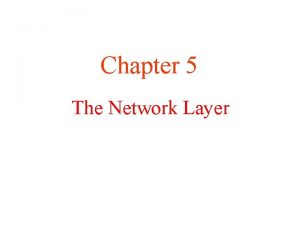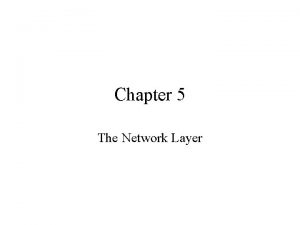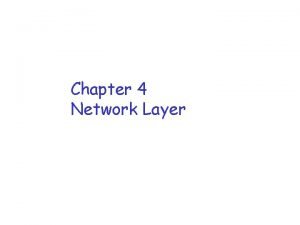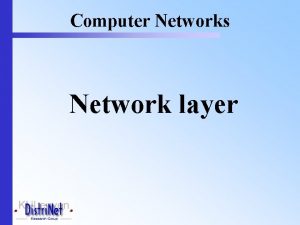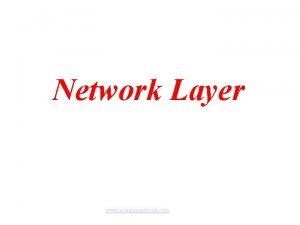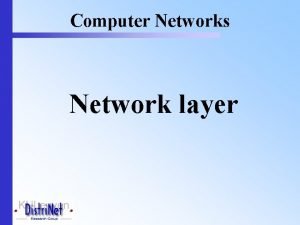Chapter 5 The Network Layer Network Layer Design



















- Slides: 19

Chapter 5 The Network Layer

Network Layer Design Isues • • • Store-and-Forward Packet Switching Services Provided to the Transport Layer Implementation of Connectionless Service Implementation of Connection-Oriented Service Comparison of Virtual-Circuit and Datagram Subnets

Routing Algorithms • • • The Optimality Principle Shortest Path Routing Flooding Distance Vector Routing Link State Routing Hierarchical Routing Broadcast Routing Multicast Routing for Mobile Hosts Routing in Ad Hoc Networks

Routing Algorithms (2) Conflict between fairness and optimality.

The Optimality Principle (a) A subnet. (b) A sink tree for router B.

Shortest Path Routing The first 5 steps used in computing the shortest path from A to D. The arrows indicate the working node.

Distance Vector Routing (a) A subnet. (b) Input from A, I, H, K, and the new routing table for J.

Distance Vector Routing (2) The count-to-infinity problem.

Link State Routing Each router must do the following: 1. Discover its neighbors, learn their network address. 2. Measure the delay or cost to each of its neighbors. 3. Construct a packet telling all it has just learned. 4. Send this packet to all other routers. 5. Compute the shortest path to every other router.

Learning about the Neighbors (a) Nine routers and a LAN. (b) A graph model of (a).

Measuring Line Cost A subnet in which the East and West parts are connected by two lines.

Building Link State Packets (a) A subnet. (b) The link state packets for this subnet.

Distributing the Link State Packets The packet buffer for router B in the previous slide (Fig. 5 -13).

Route Discovery a) (a) Range of A's broadcast. b) (b) After B and D have received A's broadcast. c) (c) After C, F, and G have received A's broadcast. d) (d) After E, H, and I have received A's broadcast. Shaded nodes are new recipients. Arrows show possible reverse routes.

Route Discovery (2) Format of a ROUTE REQUEST packet.

Route Discovery (3) Format of a ROUTE REPLY packet.

Route Maintenance (a) D's routing table before G goes down. (b) The graph after G has gone down.

Fragmentation (a) Transparent fragmentation. (b) Nontransparent fragmentation.

Fragmentation (2) Fragmentation when the elementary data size is 1 byte. (a) Original packet, containing 10 data bytes. (b) Fragments after passing through a network with maximum packet size of 8 payload bytes plus header. (c) Fragments after passing through a size 5 gateway.
 Network layer design
Network layer design The network layer is concerned with of data
The network layer is concerned with of data Network layer design issues
Network layer design issues Design issues of network layer
Design issues of network layer Network systems design using network processors
Network systems design using network processors Pigmented layer and neural layer
Pigmented layer and neural layer Phases of deglutition
Phases of deglutition Secure socket layer and transport layer security
Secure socket layer and transport layer security Presentation layer functions
Presentation layer functions Secure socket layer and transport layer security
Secure socket layer and transport layer security Secure socket layer and transport layer security
Secure socket layer and transport layer security Secure socket layer and transport layer security
Secure socket layer and transport layer security Layer 2 e layer 3
Layer 2 e layer 3 Layer-by-layer assembly
Layer-by-layer assembly Layer 2 vs layer 3 bitstream
Layer 2 vs layer 3 bitstream Hát kết hợp bộ gõ cơ thể
Hát kết hợp bộ gõ cơ thể Bổ thể
Bổ thể Tỉ lệ cơ thể trẻ em
Tỉ lệ cơ thể trẻ em Chó sói
Chó sói
